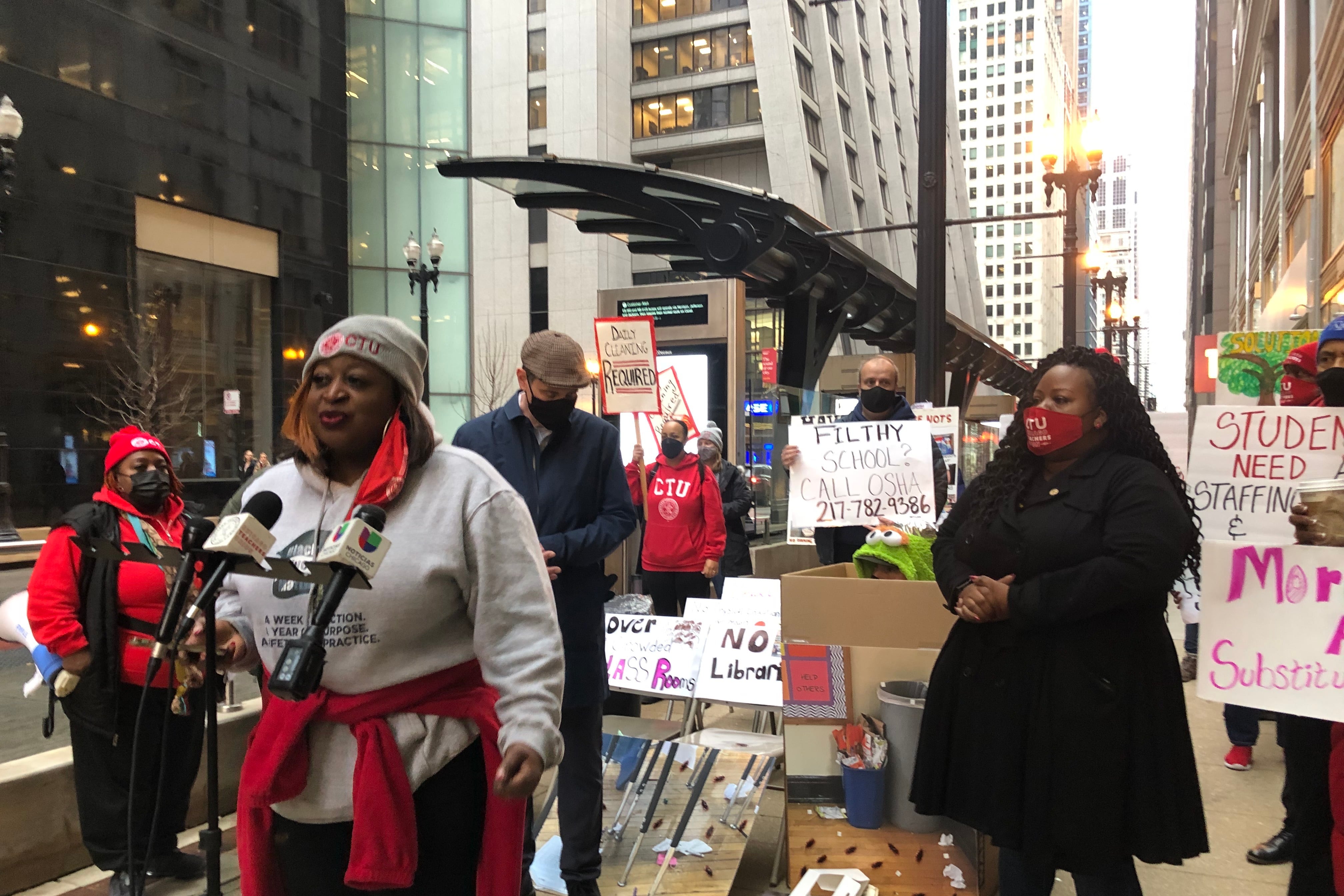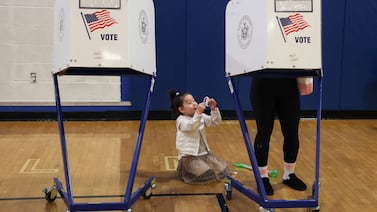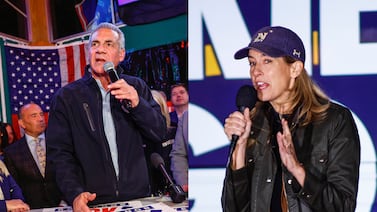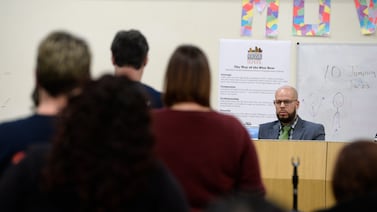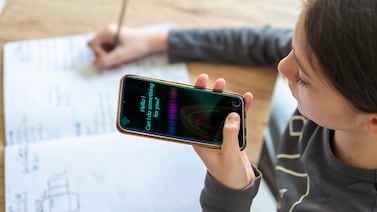A majority of Chicago teachers voted to refuse to report to school buildings Wednesday because of concerns over COVID safety and the city’s rising positivity rate, effectively shutting down the nation’s third-largest school district for the day — and possibly for days to come.
The union said 73% of voting rank-and-file members opted to pause in-person learning and teach remotely until Jan. 18 or until COVID rates declined. Voting took place electronically Tuesday evening after a meeting of the union’s delegate body, with 14,290 teachers voting in favor of the remote-work-only resolution and 5,208 voting against out of the group’s total 25,000 membership.
Earlier in the day, Chicago schools chief Pedro Martinez said that if union educators voted to not report to work in person, classes would be canceled Wednesday. Following the vote results being made public, Chicago Public Schools released a statement calling the vote an “unfortunate decision.”
“We are deeply concerned about this decision but even more concerned about its impact on the health, safety, and well-being of our students and families,” the district said in a statement. CPS said it would share a plan with families about student learning moving forward by the end of the day on Wednesday and shared a list of sites that will offer emergency child care for families.
Martinez said Tuesday evening that he remained “committed to working with the CTU” and to reach an agreement with the union.
After-school activities, including sports, also are canceled Wednesday.
Martinez had called on the union earlier Tuesday to delay the vote and said the district had delivered a counterproposal that ostensibly met a key safety demand: school-specific thresholds for shuttering campuses when COVID cases rise — though the district’s metrics differed significantly from what the union wanted. He said the district was starting to deliver some of the 200,000 KN95 masks it had ordered for staff.
But the district’s offer fell short of meeting some of the union’s other stipulations, such as a testing requirement for students to return to school, widespread KN95 mask distribution to students as well as staff, and the return to a citywide metric that would pause in-person learning across all campuses if reached — elements that would be part of a fully signed agreement between the two parties.
In an evening press conference city officials held while the vote was underway, they blasted the union for making a call that would affect families the following day so late in the evening — and stressed teachers who do not report to school buildings Wednesday will not get paid.
Mayor Lori Lightfoot brought up the dip in attendance and increase in failing grades that students — especially Black and Latino children — saw during a largely virtual 2020-21 school year. She argued Tuesday that teachers were poised to make “a decision that would harm hundreds of thousands of Chicago families that rely on CPS for their daily needs.”
“There is no basis in the data, in science, in common sense to shut down an entire school system,” Lightfoot said. “We won’t stand idly by and accept a unilateral decision on a work stoppage.”
Martinez said that school buildings will remain open Wednesday, and students will not be turned away: “We will make sure any child who comes in is cared for.”
Union president Jesse Sharkey said Tuesday in a letter to Gov. J.B. Pritzker and legislators that “inaction on appropriate school safety measures” by Lightfoot and Chicago Public Schools leaders had brought on the vote and that the school district had rejected its previous proposals or not responded to them.
Martinez said it was not reasonable to agree to a citywide metric to close schools when 100,000 students are vaccinated.
It is not yet clear what will happen past Wednesday. Should the district leadership fail to reach agreement with the union in the next 24 hours, it will be under pressure to sanction widespread remote instruction so that students don’t miss out on valuable learning time.
Last January, when some Chicago educators refused to work in-person, the district threatened to withhold pay. The two sides ultimately reached a memorandum of understanding, which included phased-in reopening and bringing back smaller groups of students and teachers at a time. The agreement also included regular surveillance testing of teachers, weekly vaccine guarantees for union members, more work-from-home accommodations, and thresholds for closing schools should positivity rates climb.
Some schools Tuesday scrambled to send home Chromebooks, iPads, and take-home materials as working parents tried to rearrange hours, call relatives, and line up alternative child care. Others took a wait-and-see approach.
Parent Maureen Hehir said teachers at her children’s Northwest Side school sent emails to families earlier in the day to gauge who might need a device.
“Our teachers were trying to prepare for all possibilities — they are super concerned,” she said.
Hehir, who teaches special education in a west suburban district, said she was “panicked” about how to juggle her children at home and her job; her district fully reopened, and teachers are expected in person.
“The thought of taking a leave and leaving my students, who are finally making so much progress, I have this heavy heart,” she said. “What am I going to do?”
Some educators said they did not take the vote lightly, with the challenges of remote learning and the disruption it caused weighing on them.
In-person learning during the pandemic has come with its own challenges, said Erik Johnson, a social studies teacher at Curie Metropolitan High School.
“I believe remote instruction while we work to figure out the safest way to move forward is currently the best move for students, teachers, and other members of our school community,” he said about his support for the resolution.
Maria Gandara, a special education teacher at Edwards Elementary in the Archer Heights neighborhood, said she is supporting the union’s resolution as well — but would not have any appetite for a return to virtual learning that stretches past Jan. 18.
She said 10 teachers and 14 support staff members were absent at the school Tuesday, with administrators stepping in to cover some classrooms. Students attendance is down markedly as well, Gandara said.
“It’s all hands on deck,” she said. “It’s not chaos — we are still running as smoothly as possible given what we have to work with.”
She said she wants to see the district step up COVID testing and commit to reasonable metrics for transitioning school buildings hit hard by the latest surge to remote learning. But with students finally easing back into in-person learning routines and building rapport with her, Gandara does not want a prolonged virtual stretch.
“If we go remote for a long time, we will lose the kids again,” she said.
Gandara said her school was still awaiting direction from the district and did not send computers and learning materials home with students Tuesday afternoon.
Several principals who spoke with Chalkbeat on the condition of anonymity said they did not get specific instructions Tuesday on preparing for a possible in-person work stoppage. One said she got the green light to send devices home with students, but others said they held off on doing that as they waited for guidance.
The district has not released student attendance data for the first two days of this week, but these principals reported dips in attendance and anywhere from a quarter to a third of teachers and other staff members being absent from work since Monday, though they said their schools have managed by having staff step in to cover for each other.
Surging city COVID rates, crippling staff shortages, and a botched take-home testing program are all factors that have catalyzed the union’s latest action.
In late December, union leaders asked the district to pause in-person learning for two weeks or to require returning students to take negative PCR tests. The district sent multiple emails and robocalls to families over winter break encouraging testing but did not require it.
An ambitious plan to send 150,000 test kits home with families and have them returned via libraries or FedEx ended with poor results: Of the nearly 36,000 tests logged in a district database between Dec. 26 and Jan. 1, almost 70% were inconclusive (18% were positive, reflecting the city’s positivity rate that week).
On Monday and Tuesday of this week, the district logged 4,500 completed tests, with a positivity rate of 10%. Only 11 were logged as invalid.
Numbers released Tuesday by the Chicago Department of Public Health put the city’s test positivity at 23.6%, up from 17% last Friday.
Mauricio Peña contributed reporting.

